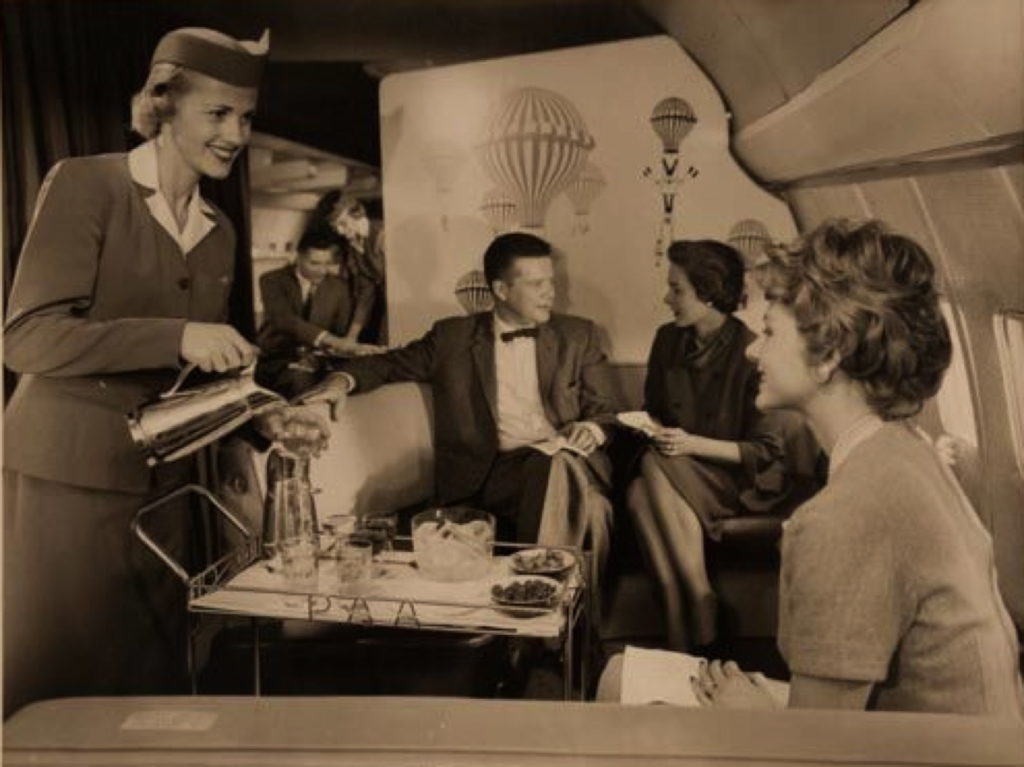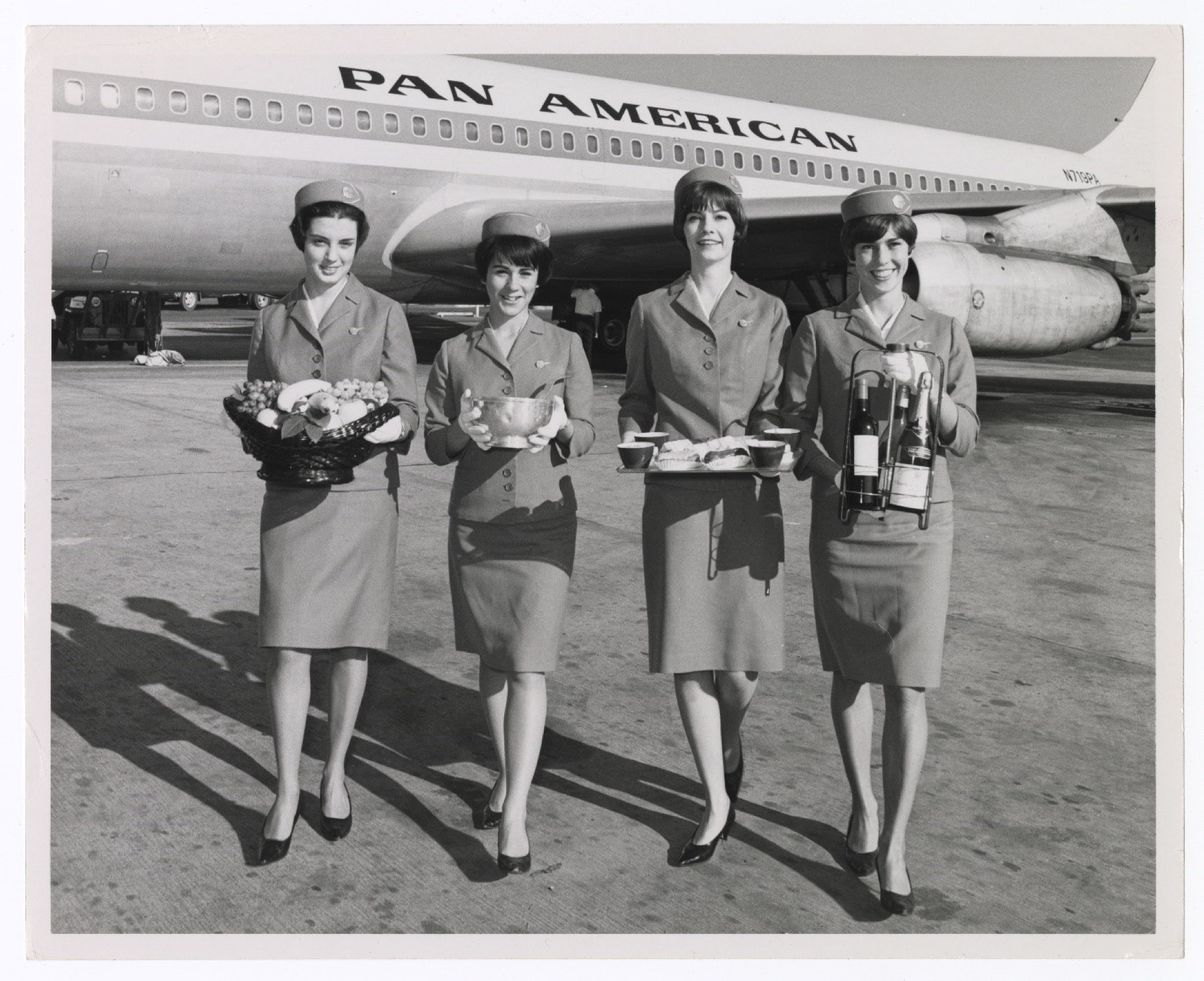Modernity's meals
The story of Pan-Am's luxury catering, its hostesses – and their role in exerting US soft power
It’s a relatively normal day in Miami when Bryce Evans knocks on the door of a suburban home. But it’s not every day you’re greeted by former flight attendants from Pan-Am’s heyday.
Evans has been welcomed to his own Pan-Am dining experience hosted by the women who worked for the famous airline. They are now in their seventies and eighties.
On arrival, he is issued with a ticket and taken through to a mock departure lounge, where he sits on the settee waiting to board his “flight”. Once ready to “board the plane” Evans takes his seat at the table and is served a delightful meal including a mouth-watering choice of mains typical of Pan-Am fare – roast tenderloin of beef, sautéed medallions of lamb, chicken suprême in ginger-pineapple sauce or poached Dover sole – accompanied by champagne, wine and liqueurs.
The crockery and cutlery used is all Pan-Am-branded since the women had kept the originals after they stopped working for the company.
“I don’t get to travel first class where you get the good food,” says Evans, associate professor in history at Liverpool Hope University. “But people ask me what’s the best airline food you’ve had, and I always answer it was actually on the ground.
“It was a faithful recollection of airline food: eight courses of really splendid food – stuff I wouldn’t usually eat personally like caviar.”
In a fascinating new book Evans explores airline food and the lives of the American airline’s hostesses, who recollect their time as employees. Pan American World Airways, formerly known as Pan American Airways, operated from 1927 to 1991 but although it’s no longer around, the love the women had for the company lives on and they have plenty of stories to tell.
“Pan-Am represents the elite, carefree golden age of air travel.”
The airline pioneered long-distance routes, made innovations in flight planning and procedures, offered flights to every continent bar Antarctica and, in 1958, ushered in the jet age with the first commercial flight of a Boeing 707, from New York to Paris in eight hours.
“Pan-Am represents the elite, carefree golden age of air travel – embodying the razzmatazz and excitement of getting on a plane, particularly in the era of pre-mass travel,” says Evans.
“Pan-Am was the vanguard of American global appeal, especially in the context of the Cold War, where it became a tool of soft power for the government. And a huge part of the appeal was Pan-Am’s proud, professional flight attendants and the food they served to passengers.”
When commercial airlines began in the 1920s, serving was food was mainly a means of distracting from what was a fearful and uncomfortable experience. It was only with the the introduction of the DC-3 airline in 1936 that Pan-Am could take advantage of a smoother, more sound-controlled flight to make a show of its food.
In 1951 Pan-Am linked up with renowned Paris restaurant Maxim’s to introduce sophisticated Gallic cuisine on to its flights. That decade also brought the sandwich wars that Evans describes in his book – an arcane legal argument that makes no sense in the current world of deregulated air travel but which ultimately prompted Pan-Am to upgrade its offer to the emerging class of economy travellers, almost to the point of its premium service.
At one point the battle hinged on the International Air Transport Association’s verdict on Pan-Am’s European rivals such as KLM and SwissAir, which had decided to pimp up their economy-class sandwiches. IATA, writes Evans, ruled “that smørrebrød could continue to be served as long as two-and-a-half centimetres of the bread remained visible”.
But Evans also details bigger themes, such as the sexism and racism in the way Pan-Am treated its air-hostesses.
During the early days, flight attendants would have all been male since women were thought to have less stamina to meet the demands of the job. But by the 1940s and 1950s, attendants were “almost 100 per cent female”, according to Evans.
Women would be hired and fired based on their appearance, including factors such as height and weight
“It ties into that very sexist post-war notion of the American housewife,” he says.
Women would be hired and fired based on their appearance, including factors such as height and weight. Some of the hiring notes Evans found in the archives were “disgustingly sexist”, he says, adding that his respect for the women grew for what they endured.
Applicants were turned down for being “plain, unattractive”, “divorced – has child”, “cold, passive”, “dumpy – head too small for body” and, unable to do right for wrong, wearing “too much eye makeup”.

Applicants fared better if they were “homely”, “lady-like”, “a pretty girl, pleasant” or had a “darling personality”.
Evans says: “They were subjected to weight checks regularly and so if you were over your allotted weight for your height that could be the basis of a disciplinary. Consequently, a lot of them crash dieted, a lot of them concealed pregnancies.”
Racism was also rife in the Pan-Am days. Women from a Japanese background or white European women were seen as having more grace when it came to serving food. Even the appearance of their hands was considered better than African-American women.
Nevertheless, none of the 30 women Evans interviewed had a bad word to say about the company and how it treated them.
“Not a single one of them felt they were victims or oppressed. All of them felt that they had a wonderful experience, even if it was sometimes quite short lived, sometimes maybe one to three years.
“They all felt that it had enriched their lives. It had educated them in things like culinary sophistication, it had provided them with a wonderful experience in their life and it’s an experience to travel the world and have a bit of fun because obviously you had layovers and they liked to party, of course.”
Party supplies were secured by smuggling alcohol off aircraft in empty coffee urns or bottles of mouthwash, he writes. One interviewee would even hide marijuana underneath her hat ribbon.

“They all had absolutely no regrets. It was quite amazing.”
In 1971, Winnifred Omodt, a 21-year-old flight attendant, was collecting entrée orders from the 60 passengers in first class before the departure of her flight from JFK to London. The prime rib, a Pan-Am favourite, was selling out, and one passenger who had ignored her on her first pass now became irate when he belatedly decided he wanted the beef as well.
Recalling the incident in an interview with Evans, Omodt says she told him the prime rib had all gone.
“Do you know who I am?” he demanded. “I could buy up every seat here.”
“But you didn’t, sir,” she replied. “And now I’m sorry, but it’s all gone.”
In an eerie foreshadowing of what was to come, he demanded Omodt tell another passenger that she had miscounted. Two weeks later when the 25-year-old man made a complaint to her bosses she found out his name was Donald Trump.
Omodt told Evans: “Thankfully, our supervisors never assumed that passenger complaints were well-founded. And, in this case, after hearing my side, the managers actually said: ‘Thank you for doing the right thing.’”
Posh food began to be seen as an anachronism and the airline began to run down its catering service
But Pan-Am’s fortunes were already in decline by then, because deregulation had brought more competition – bringing worsening working conditions for cabin staff – and fuel prices had risen. Posh food began to be seen as an anachronism and the airline began to run down its catering service.
In 1988 Pan-Am flight 103 from Heathrow to New York exploded over Lockerbie and the company – a highly symbolic target for terrorists – was held responsible for failing to prevent someone taking a bomb on board. Less than three years later Pan-Am filed for bankruptcy.
“The book is really a snapshot of American global leadership in the 20th century and American modernity,” says Evans. “America flourished through its technology for much of the 20th century but the point where we’re at now, the American airlines have gone way downhill.
“The best luxury travel and luxury food experience now is with non-American airlines like Emirates, Singapore Airlines, Thai Airways. Qantas are very good, Turkish airlines are good. Turkish Airlines do really excellent food.
“So no, I don’t think luxury travel is dead but that American vision of luxury travel and abundance, probably best encapsulated in the Frank Sinatra song Come Fly With Me, that sort of 1950s and 1960s glitz and glamour – with everything that was brilliant and bad about that – has now gone.”
The global pandemic has dramatically cut air travel. The aviation industry has sold its pre-packaged food online during lockdown periods. Singapore and Thai airlines even started to hold on-the-ground experiences, where people can pay to sit in a plane on the runway, without flying anywhere, and indulge in airline food.
“Regrettably it’s led to a lot of lost jobs and a really hard time for the industry. However, I can see a bounce-back. When this is all over will people still be wanting to take cheap flights to Spain? I’m sure they will. Will some people want to be experiencing five-star, very expensive luxury international long-haul flights? I’m sure they will.
“I don’t think it’s the end of the aviation industry but it will have to adapt. I don’t necessarily think it’s the end of good airline food… It’s a really amazing scientific achievement to be able to serve decent food in the air because of what happens to your taste buds, the scientific pressures of altitude and pressure and lack of humidity.
“I hope with this book to restore airline food to its proper place and for people to be a bit fairer towards poor old airline food.”
Food and Aviation in the Twentieth Century: The Pan-American Ideal by Bryce Evans is published by Bloomsbury Academic

Leave a reply
Your email address will not be published.